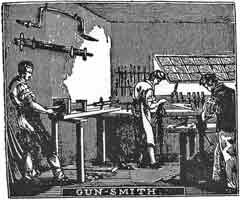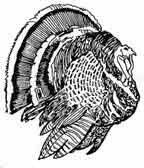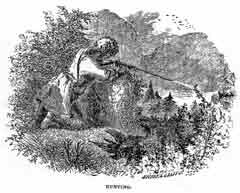
Discover rewarding casino experiences. 
Click on the Flag for More Information |
No one knows who created that first historical gun the "Kentucky rifle" around 1700, but it is known where. In eastern Pennsylvania. The European rifle that the first settlers/colonials had brought with them were heavy, awkward, inaccurate but fearsome. They were destructive to both the target and the shooter. The smoke and noise awed both the Indian and the game at which the gun user was aiming. It took some getting used to. It was only by practice that a target could be accomplished but the remote cabin, the blockhouse, an individual could be protected by the awesome gun of the frontiersmen. Those frontiersmen ranged the wilderness up to the Allegheny mountains for several years until Dan'l Boone and others discovered the Cumberland Gap and other passes to go beyond "civilization" ... Always with the help of his gun to protect, harvest the plentiful game and so forth. That wilderness was generically called "Kentucky." The mysterious, unknown land to the West was generally known by that label and into it the explorers carried the clumsy, inaccurate European rifle which on an average took almost fifteen minutes to load each shot. An amazing amount of powder had to be packed into the barrel, then the lead ball put down the muzzle, driven down it by a sturdy ramrod and a mallet to pound it home. The ball often damaged the rifling of the barrel by this method and the ball was often bent askew which affected the trajectory to commonly deflect the ball. The explosion regularly backhanded the shooter to his detriment, too.
Among the emigrants who came in the "olden times" were from Switzerland and Germany, many of whom had been gunsmiths who in their homeland produced excellent, but still primitive guns of the times. Many of those people settled in Eastern, Pennsylvania at the edge of "civilization" where their abilities were called on for weapons of the dawning new day. Hickory Town in 1718 was a center of gunsmith expertise and yet in by 1730 when it was a more formidable gathering known as Lancaster around which one simple, singular innovation came about which changed the course of gunmaking there and throughout the world. Because the wilderness was generally known as "Kentucky" the gun became known as the "Kentucky rifle" although it was sometimes called the "long rifle" or the "American rifle" even though developed in Pennsylvania. That simple "invention" if you want to call it that was a piece of buckskin or linen about the size of a silver dollar that was treated with tallow to make it "greasy" to slide more easily. Thus it could be driven down the barrel faster, protecting both the rifling and the ball. It was more economical in that less powder was necessary. Trhiftiness was a way of life. The patch also sealed in the gases released at the explosion to expel the pellet at more velocity and accuracy. Being that there was less noise, it protected the shooter somewhat from retaliation, the flare, too, was lessened. A string of greased patches to fill the patchbox on the rifle was a symbol of the serious frontiersman. No matter if it was the small patch or a large one draped across the muzzle, the loading time was considerably shortened from the average fifteen minutes to twenty or thirty seconds, believe it or not. Some practiced marksmen could fire off four or five shots a minute. What an advantage as a bear or a Britisher was charging. That odd little improvement of the greased patch made possible the eventual development of the longer, lighter Kentucky rifle which helped tame the wilderness.
"It's a Pennsylvania Custom" states that European rifles with calibers of .60 and .70 could be scaled to .45 and thereabouts. And although it took less lead for the individual pellet, more of them were used, perhaps three times as many, because the shooter was using many more on his quests due to faster loading time. The long rifle stood fifty-seven to fifty-eight inches high, to a man's shoulder. And weighted ten pounds and more ... Quite impressive but they weren't standard. Each gun was handmade, mostly to order ... Make me one like Pappy's, my brothers like this one, only heavier ... The gunsmith could do that in about a week after the last steps of carving the butt from some local hardwood, perhaps curly maple, which he rubbed and rubbed with soot and oil until the wood grain glowed with life ... And which was lovingly caressed through years to come by the owner who'd got food and pelts, saved lives, won competitions and called the gun by name and thought of it as his companion. The first center of its craftsmanship had been eastern Pennsylvania but as the mountains and forests were breached and the prairies of the Midwest were discovered to be eyed with suspicion, the gunsmiths went westward also to follow the trade. The "smiths" of the eastern seaboard and New England states came onward to Illinois. There is little record of them; only local mention here and there. Prior to 1850 the federal census did not list citizens' occupations. Record does show a Frenchman as gunsmith at Ft. de Chartres as early as 1739, Antoine Deshuitres. The earliest record of someone from the East in Illinois' gunsmith trade as Jacob Judy who had emigrated from Switzerland to Ft. Pitt (PA) in 1777 where he remained during the Revolutionary War but then came West to Kentucky. By 1788 he and family were on the move again to Kaskaskia, Illinois where he made guns until probably 1792. He then moved to southeast of Waterloo, Illinois where it is assumed he plied his trade until his death in 1807. There is thought to have been eight hundred gunsmiths in Illinois at the high point of their professional manufacturing by hand, that household necessity, the gun circa 1840 til about 1875. Factory-made guns flooded the market by then. Gunsmiths were rarely documented nor did they have to advertise. Word-of-mouth spread names and expertise far and wide. Besides newspapers weren't that common in the early days of statehood. Most known gunsmiths were in Southern Illinois where first settlement occurred but, naturally Galena, the lead capitol of the nation, had a gunsmith whose talents were put to use in that rugged region by 1832, Dudley Simmons. Curt Johnson, Princeton, Illinois, noted gun historian, lists a few other area gunsmiths such as John Dittman whose name is seen stamped on a few pieces Samuel Hinsdale stamped his name on that top "facet" of the octagonal barrel with Princeton, Illinois also where he'd arrived in the late 1830's and reached a peak of some reknown by the 1850's. From the first he'd catered to the Westward-bound buyer by advertising "Emigrants to the states of Oregon and California will find it to their interest to call on the subscriber to purchase an Oregon rifle." He made hunting and target rifles also for the local trade until his death in 1875. Many old handmade guns are to still be seen here and there throughout Illinois even in the small towns. "H. Goedeke, Olney, Illinois," "Charles Matthews, Oquawka, Illinois," "Hiram White, Olney, Illinois." By the 1870's the handmade gun was rapidly declining in make, the gun that had Won America! Freeborn Garrison, Lanark, may have been a repairer of guns by the '70's. The town's weekly periodical mostly mentioned his scuffles with merchandiser, J.R. Eby on Broad Street rather than what sort of gun work he did! Guns were still employed for hunting the last quarter of the nineteenth century. And they became sporttarget competitions. Those were social times and are frequently reported in the weeklies from Elkhorn Grove, southeast Carroll County. Likely at the Spencer Plow Factory, don't you suppose! More will now be searched for on that idea. Quoting a source about those rifle competitions it emphasized that NEVER were the traditional "bulls-eye" target of concentric circles EVER used in the "olden days." That where a prize of a horse or oxen, gun, knife, shirt or some necessity in the less affluent neighborhoods would be competed for, perhaps, beginning at 200 yards but more likely reduced to one hundred yards with a smaller, more active target ... A turkey. A bird gathered in the woods would be tethered to a stake behind a log or stump with only its head showing ... Nervous, unpredictable, erratic, the poor fowl would be shot at from the proscribed distance ... Head off, you got the bird! Thank goodness, eh, we don't now have to obtain our holiday main course in such a barbaric way but which once was how our frontiersmen ancestors made sport of a necessitytable food.
|






